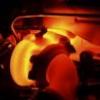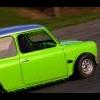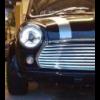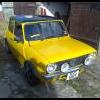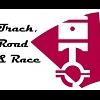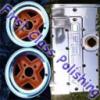track of a car is very important. not only for handling, but for economy.
if your wheels arnt pointing in a straight line then you are constantly scrubbing your Tyre. this not only reduces the Tyre life but costs your more in fuel to rub away your nice new tires.
on the handling front, the toe of the front wheels can change the feeling of the car dramatically. more toe in on the front will help the car turn into corners better but loose speed and get a bit "skity" on long straights.
the joy of doing this yourself is that if you don't like how the car is handling or you have made some grave mistake, you can always set it back to its base settings so you cant go wrong really (unless you go lathering round the roads when you have just changed something...).
im not saying that track is the be all and end all of suspension settings, far from it. but its a good start and for what it costs, its a very cheap good start.
what you need is
two straight bars. i use steel box section.
some visible fishing line - i use pole elastic. the fishermen around here will know what im on about. ill explain why elastic rather than string later.
a steel rule
1. get your bars and weld or put a bolt through each end of the bars. the bars need to be roughly 12-15 inches longer than the width of the mini.
if you have wide arches and wheels then add a bit extra. the bolts need to be the same length apart on the bars. this is crucial so spend a bit of time getting it spot on. try to use small bolts like m5 / m6 this ill keep the elastic / string central on the bolt. say 1 inch box is used, use a 2 inch bolt so there is plenty left sticking out of the bars. this needs to be done at all four ends of the bars.
2. next get the bars and figure out a way of mounting them at the front and the back of the car. they need to be at the same height as the stub axles. i just drilled some some and used cable ties but if you value your paint job i wouldn't recommend drilling holes. the bars need to be solid but be able to move side to side.
3. next get the elastic roughly half the length of the mini and tie a hole in each end. put each loop round the bolts on one side of the car and do the same with the other. the reason i use elastic is it keeps tought when measuring against.
should look a bit like this paint master piece. just a bit more colorful.

4. now you have to square the elastic up to the car. you do this by using a steel rule and measuring from the stub axle to the elastic. you do this on side of the car. then move the bars until the measurement from one side is exactly the same as the other.
if you start with the front one and then go to the back one, make sure the front one is still right. you need to get this bob on.
5. now measure the distance between the front edge on the wheel and the back edge. the difference is your track in mm or inch.
the base settings i use for road mini's is
1/16th or about 2mm toe out on the front.
1/16th or about 2mm toe in on the back.
just to clarify toe in and toe out.
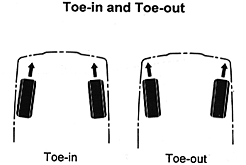
and that's it. any questions or anyone disagrees with anything iv said then please get in touch.


